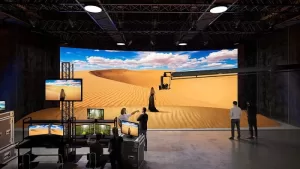Revolutionizing Filmmaking: How XR LED Screens Are Changing the Game

News Mania Desk / Agnibeena Ghosh/24th April 2024
Fans of The Mandalorian may recall the excitement surrounding its innovative filming techniques upon its release. In February 2020, American Cinematographer Magazine detailed how the show raised the bar for film and TV production by eschewing traditional green screens in favor of massive LED walls powered by Unreal Engine, a technology known as StageCraft.
This cutting-edge approach, while not simplifying the filming process, significantly reduced the time and effort required for on-location shoots or motion-capture setups involving actors.
OpenText, an information management software company, leveraged similar extended reality (XR) technology to produce three commercials for its Live a Better Digital Life campaign. Launched in late March, the campaign promotes the cybersecurity company Webroot.
Here’s a simplified explanation of how the technology works: High-resolution LED screens display images generated in Unreal Engine as backgrounds behind the actors. Initially resembling video game graphics, these images take on a more realistic appearance when captured by a camera lens, thanks to techniques like blur and depth of field.
To maintain realism while the camera is in motion, Unreal Engine dynamically adjusts the captured image based on the lens’s positioning.
OpenText’s campaign utilizes this technology to subvert the typical fear-based messaging associated with antivirus software. Instead of flashing alarms and ominous red flags, the commercials depict a vibrant, Wes Anderson-esque film set bathed in green and yellow hues—colors symbolizing freedom and caution, respectively—while avoiding red, reinforcing the message of Webroot’s software: protecting users from scams and cyber threats.
“We used technology to blend practical and digital elements in a way that reinforces the message,” explained Chris Sojka, cofounder and chief creative officer of Madwell, the agency behind the campaign. “The motion work prompts viewers to question what’s real and what’s not.”

Implementing this new technology required significant investment from Madwell, totaling approximately $750,000 in additional resources for labor and experimentation. While OpenText’s budget did not cover these expenses, the company ultimately saved up to $2 million by forgoing physical set construction and streamlining post-production.
Given its cost-saving benefits and efficiency, LED walls may become a more common fixture on commercial sets in the future. Sojka believes that pushing the boundaries of this technology allows agencies to deliver high-quality content at the speed of culture, a feat previously unattainable.
However, working with XR technology presents its challenges. Sojka emphasized the technical complexity involved, noting that without a thorough understanding of its capabilities, it’s easy to encounter obstacles. Additionally, XR technology can strain the processing power of the PC running Unreal Engine, particularly during shoots when real-time adjustments are necessary.
As agencies continue to navigate the use of emerging technologies like XR LED screens, Sojka stresses the importance of brands being open to experimentation and innovation. Establishing new processes may require time and flexibility, but the potential benefits for storytelling and production quality are undeniable.







